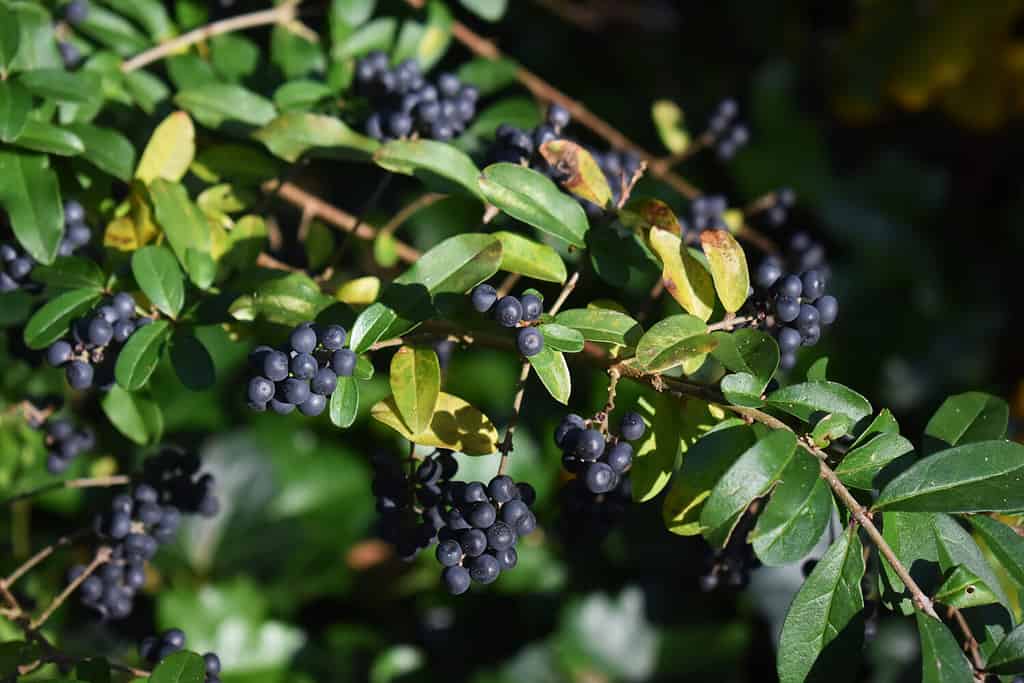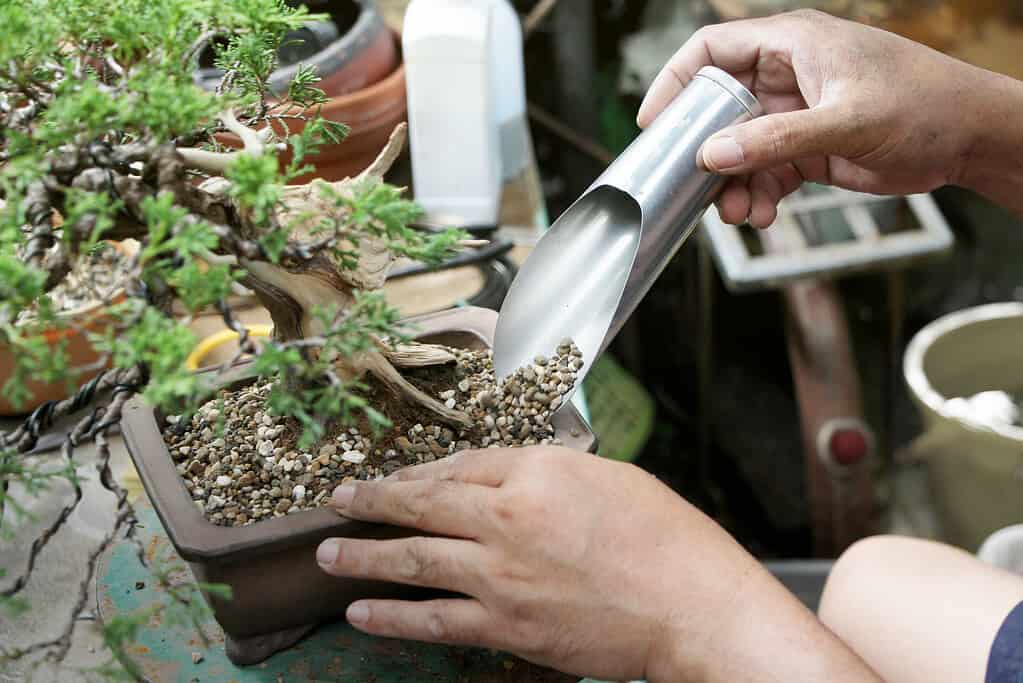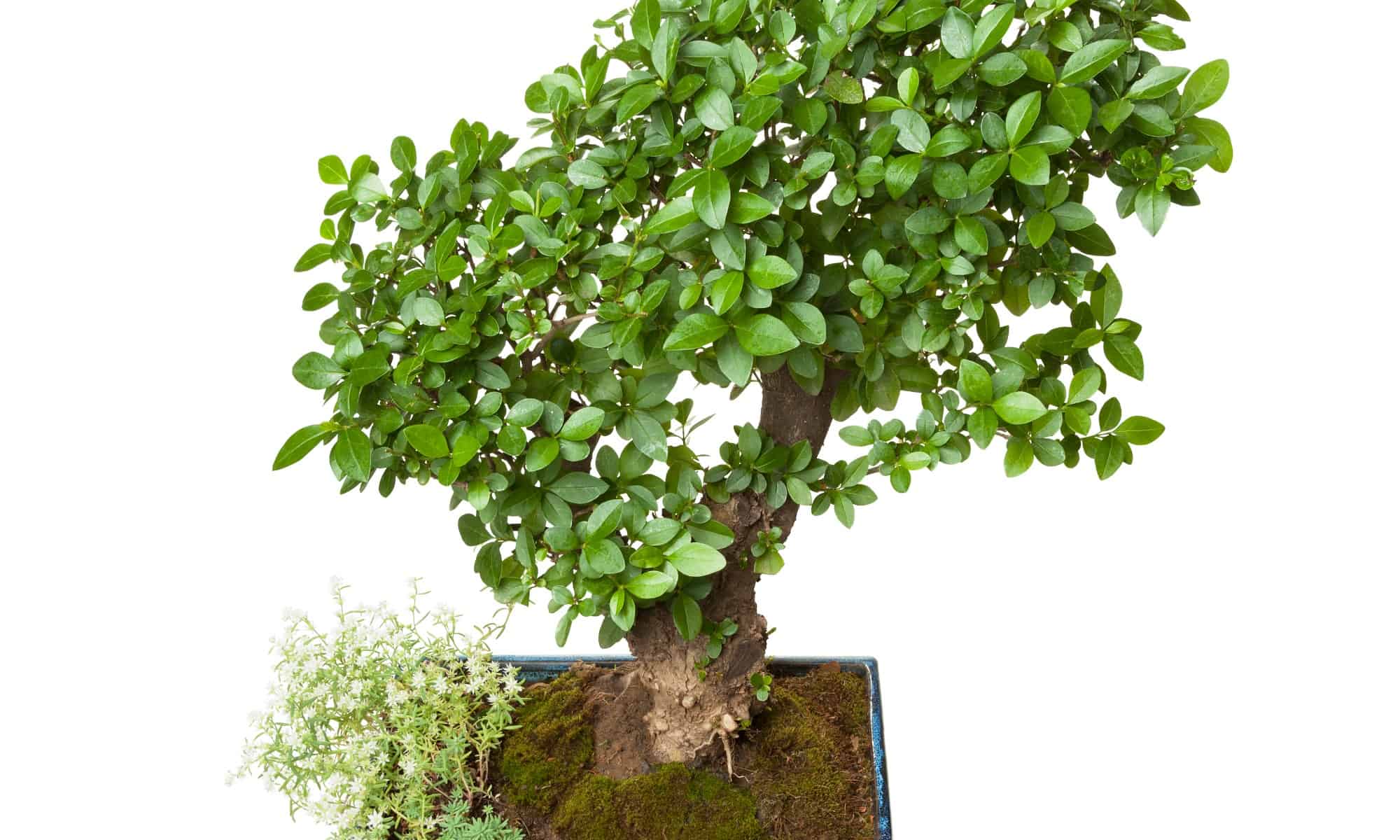Step into the world of captivating green artistry with privet bonsai trees. These miniature marvels, meticulously sculpted by skilled hands, hold nature’s beauty in the palm of your hand. Privet bonsai trees are a living testament to the seamless marriage of horticulture and aesthetics.
Intriguingly, these bonsai trees originate from the privet shrub, a resilient plant known for its adaptability. Through patient cultivation and shaping, privet shrubs are transformed into captivating bonsai specimens. Their leaves are trimmed with precision, and their trunks are gently coerced into elegant twists and turns.
In this guide, we’ll get into everything you need to know about growing your very own privet bonsai!
Quick Information on Privet Bonsai Trees
| Privet Bonsai Tree Facts | |
|---|---|
| Botanical Name | Ligustrum genus |
| Popular Options | Chinese privet, Japanese privet, oval leaved privet |
| Sunlight | Full sun or partial shade |
| Soil | Well-draining soil with organic fertilizer |
| Water Needs | High |
| For Beginners? | Yes |
| Indoors or Outdoors? | Both |
| Pairs Well With… | Ceramic, moss, grass, small flowers |
Caring for Your Privet Bonsai
A privet bonsai tree is not just a plant; it’s a living masterpiece that requires thoughtful care to flourish. Whether you’re a seasoned bonsai enthusiast or a beginner taking your first steps into this world of green artistry, providing the right care will ensure the health and beauty of your privet bonsai tree.
Placement Matters
Selecting the right spot for your privet bonsai tree is essential. These trees thrive in bright, indirect sunlight. Placing your bonsai near a south- or west-facing window can provide optimal light conditions. Avoid exposing your bonsai to harsh, direct sunlight, as it can scorch the leaves.
Water Wisely
Maintaining proper moisture levels is crucial. When the top inch of the soil feels dry to the touch, it’s time to water your bonsai. Use a watering can with a fine nozzle to avoid disturbing the soil. Ensure that the water seeps through the entire root ball. Allow excess water to drain from the pot to prevent waterlogging, which can harm the roots.
Get the Humidity Right
Privet bonsai trees appreciate a bit of humidity. You can provide this by placing a tray filled with water and pebbles beneath the bonsai. As the water evaporates, it creates a humid microenvironment around the tree. You can also mist the leaves occasionally, especially during dry periods.
Fertilize with Care
Feeding your privet bonsai tree with balanced fertilizer is essential for its growth. During the growing season (spring through early autumn), use a diluted liquid fertilizer every two to four weeks. Be cautious not to over-fertilize, as it can lead to excessive growth or weak branches.
Repotting for Renewal
As your bonsai tree grows, it will need repotting every two to three years to provide fresh nutrients and space for the roots to expand. Spring is the best time for repotting, as the tree is entering its active growth phase. Gently remove the tree from its pot, trim the roots, and repot it in fresh bonsai soil.

Privet are known for growing deep blue berries, which are toxic to humans and dogs.
©Gabriela Beres/Shutterstock.com
Pruning Your Privet Bonsai
Pruning is an essential skill when it comes to maintaining the health and aesthetic appeal of your privet bonsai tree. Through strategic cutting and shaping, you can encourage growth, control its size, and create a harmonious design.
Gather the Right Tools
Before you begin, gather the necessary tools: sharp bonsai shears, concave branch cutters, and wire cutters. Make sure these tools are clean and well-maintained to prevent any damage to the tree.
Choose the Right Time
Pruning should ideally be done during the tree’s active growth periods, which are spring and summer. Avoid pruning during the dormant winter months, as the tree’s recovery ability is reduced.
Identify Your Goals for Pruning
Determine the goals of your pruning. Do you want to shape the bonsai, encourage new growth, or maintain its size? Clear goals will guide your pruning decisions.
Remove Dead and Diseased Branches
Start by inspecting the tree for dead, damaged, or diseased branches. Use the sharp bonsai shears to carefully remove these, cutting back to healthy tissue. This not only improves the tree’s appearance but also prevents the spread of disease.
Thin Out Excess Growth
Privet bonsai trees tend to develop dense foliage. To allow light and air to reach all parts of the tree, thin out areas with excessive growth. Use your shears to selectively trim back branches, opening up the canopy.
Consider Branch Placement
Evaluate the tree’s structure and branch placement. Trim branches that cross each other or grow towards the inside of the tree. Keep branches that contribute to the overall design and balance.
Use Concave Cutters for Larger Branches
For larger branches, employ concave branch cutters to create clean cuts that heal well. Make a first cut on the underside of the branch, followed by a second cut a bit further out. This prevents bark from tearing and encourages proper healing.
Use Wiring for Shape
If you’re aiming to shape your privet bonsai tree, consider using bonsai wire. Wrap the wire around branches to gently guide them into the desired position. Be cautious not to wrap the wire too tightly to avoid damaging the bark.
Provide Regular Maintenance
Pruning is not a one-time task. Regular maintenance is crucial to the health and beauty of your privet bonsai tree. Keep an eye on new growth and trim it back periodically to maintain the desired shape.
Have Patience and Observe
Patience is key in bonsai pruning. Observe how your tree responds to each pruning session. Over time, you’ll develop a better understanding of its growth patterns and needs.

Regular maintenance of your tree’s soil is also a necessary part of ensuring it grows properly and stays healthy.
©iStock.com/PAKAPORN YAMANON
Propagating Your Privet Bonsai
Propagating a privet bonsai tree can be a rewarding experience that allows you to create new trees while honing your skills as a bonsai enthusiast. With the right techniques and a little patience, you can multiply your bonsai collection.
Choosing the Right Time to Propagate
Timing plays a crucial role in successful propagation. The best time to propagate privet bonsai trees is during the active growing season, which typically falls in spring or early summer. This is when the tree’s natural growth hormones are most active, aiding in the rooting process.
Selecting a Healthy Parent Tree
Choose a healthy and robust parent tree for propagation. The parent tree’s characteristics will influence the traits of the new plants. Look for a privet bonsai tree with desirable attributes such as shape, foliage density, and overall health.
Types of Propagation
There are two main methods of propagating privet bonsai trees: cuttings and air layering.
Propagation by Cuttings
- Select a healthy branch that is about four to six inches long.
- Use sharp and clean pruning shears to make a clean cut just below a node (the point where leaves attach to the stem).
- Remove the leaves from the lower half of the cutting to reduce moisture loss.
- Dip the cut end into a rooting hormone to encourage root development.
- Plant the cutting in a well-draining potting mix and keep it consistently moist. Covering the pot with a plastic bag can create a humid environment that aids in rooting.
- Place the pot in a location with bright, indirect light.
- Once roots have formed, usually in a few weeks to a couple of months, you can transplant the new plant into a larger container.
Propagation by Air Layering
- Choose a healthy branch where you want the new roots to grow.
- Make a shallow cut around the branch’s circumference, about 1 inch above where you want the roots to develop.
- Apply rooting hormone to the wounded area.
- Wrap the cut branch section with damp moss. Then, cover it with cling plastic wrap to create a sort of greenhouse effect.
- Secure the moss and plastic wrap with twine or rubber bands.
- Check regularly to make sure the moss remains wet.
- After a few months, roots will have formed. Carefully cut below the rooted section and pot it in a well-draining mix.
Nurturing New Plants
Once you’ve successfully propagated your privet bonsai tree, provide proper care to ensure its healthy growth. Place young plants in a shaded area to protect them from direct sunlight initially. Keep the soil consistently moist but not waterlogged. As the plants mature, gradually expose them to more sunlight and adjust watering accordingly.
Again– Be Patient!
Successful propagation requires patience. Regularly monitor the progress of your new plants. Over time, you’ll see signs of growth and establishment, indicating that your efforts have paid off.
Common Problems for Privet Bonsai Trees
Navigating Common Problems and Threats for Privet Bonsai Trees
Caring for a privet bonsai tree is a gratifying experience, but like any plant, it can face challenges. To ensure the health and longevity of your bonsai, it’s essential to be aware of potential problems, pests, and diseases that might arise.
Pests
Aphids can be a major problem for privet bonsai trees. These tiny insects feed on the sap of privet bonsai trees, causing leaves to curl and distort. Use a strong stream of water to dislodge them or employ natural predators like ladybugs.
Scale insects are another potential threat. These pests appear as small, round bumps on branches. They damage plants by sucking sap. You can gently scrub them off with a soft brush dipped in soapy water.
Spider mites can also be problematic. Spider mites are barely visible to the naked eye, but they leave fine webs on leaves. They pierce cells to feed, causing stippling and discoloration. Regularly misting the trees and maintaining humidity can deter them.
Diseases
Powdery mildew is a fungal disease that appears as a white powdery substance on leaves. Adequate air circulation and avoiding overhead watering can prevent its occurrence. If it does appear, treat it with fungicidal soap.
Leaf spot is another potential disease to watch out for. Caused by various fungi, leaf spots are circular lesions with distinct borders. They can lead to premature leaf drop. Prune affected leaves and ensure good ventilation to prevent spread.
Root rot is another common problem. Excessive moisture in the soil can lead to root rot, causing roots to decay. Ensure proper drainage and avoid overwatering to prevent this disease.
Nutrient Deficiencies and Incorrect Care
Signs of nitrogen deficiency include yellowing of older leaves and stunted growth. Apply a balanced fertilizer with higher nitrogen content to address this deficiency.
Iron deficiencies can also be a problem. New leaves turn yellow while veins remain green. Correct soil pH and use iron chelates to alleviate this issue.
There’s also the issue of overwatering. Excess moisture can lead to root rot and attract pests. Water your bonsai thoroughly but allow the soil to dry out between waterings. Underwatering is similarly problematic. Insufficient watering causes leaves to wilt and brown. Regularly check the moisture level of the soil and adjust watering accordingly.
Your privet bonsai can also get sunburned. Too much direct sunlight can scorch leaves. Gradually acclimate your bonsai to brighter conditions and provide shade during the hottest parts of the day.
In that same vein, your bonsai could also sustain damage from cold. Privet bonsai trees are very susceptible to cold damage. Protect them from frost and freezing temperatures, especially during winter.
Thank you for reading! Have some feedback for us? Contact the AZ Animals editorial team.








